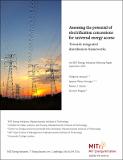| dc.description.abstract | The situation of energy access in Sub-Saharan Africa remains critical. According to the 2019 Tracking SDG 7: The Energy Progress Report, about 573 million people lacked access to electricity in 2017. Despite the proclaimed UN’s Sustainable Development Goal #7 (SDG 7) of a global energy access by 2030, the Agency forecasts that nearly 600 million Africans will still live in the dark.
As a matter of fact, Sub-Saharan Africa has demonstrated limited progress in energy access over the past decade. Less than a third of the region experienced electrification rates faster than 1% per year due to ailing electrification policies and rampant demographic pressure, and World Bank estimates suggest that the continent may not be in a position to achieve universal energy access with the next 50 years under current policy scenarios. While various governance and financial models have been attempted over the past decades in order to foster private investments in energy access, sustainable and replicable business models for universal energy access remain elusive.
As national utilities still struggle to escape financially unsustainable business models and cycles of regular bankruptcy and bailouts, the new momentum in the energy access sector has sparked growing interest in the development of innovative governance models to restructure the distribution sector and accelerate electrification. An estimated $52 billion of investment is needed per year to reach universal electricity access by 2030 – a figure that far exceeds the $30 billion committed in 2015-16 and that is out of reach for public agencies. As a result, increased attention is being paid to business models that can attract private capital under socially, politically and economically sustainable terms.
Concession agreements, in which “the government grants a private company the right to extend a specific service under conditions of significant market power,” offer an interesting middle ground between traditional State-owned approaches to distribution and entirely private sector-driven strategies. While this model has already been tested in a number of Latin American, Asian and mostly African countries with mixed results, recent technological breakthroughs and the large experience derived from past experiences in the design and implementation of concessions may now pave the way for bright prospects for universal energy access.
This study aims at demonstrating that properly designed and implemented concession agreements designed at the utility-level may lead to significant breakthroughs in reviving ailing utilities and reaching universal energy access. Building on a brief historical overview of past electrification attempts, the authors of this paper argue that tailored electrification models will be needed to reach universal energy access on the African continent. In practice, a review of past concession experiences demonstrate that national utility-scale concessions may hold the most potential provided that such agreement entail well-defined financial sustainability and energy access-specific clauses open to periodic revision. This paper concludes by proposing an actionable approach to implement concessions to accelerate electrification. It elaborates on the concept of Integrated Distribution Framework, whereby an entity is granted with a well-designed territorial concession and adequate incentives with the mandate of achieving full electrification under stringent quality of service requirements. | en_US |
